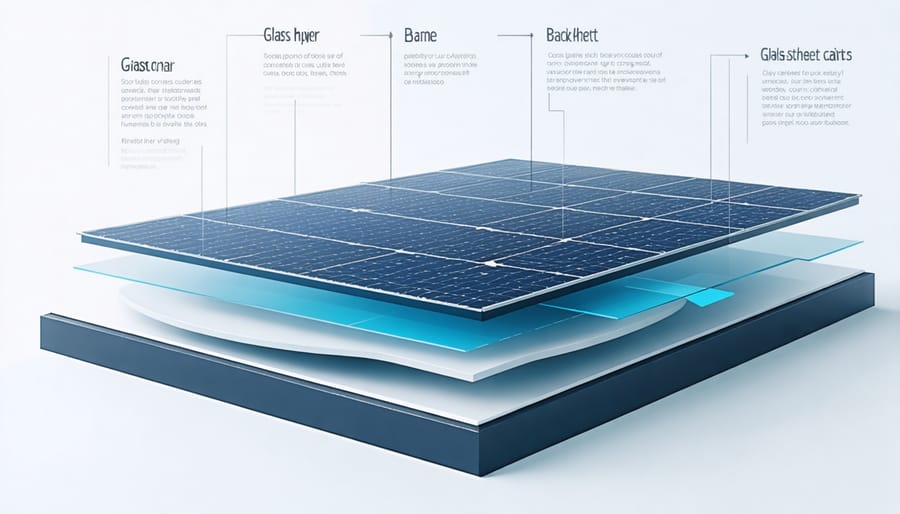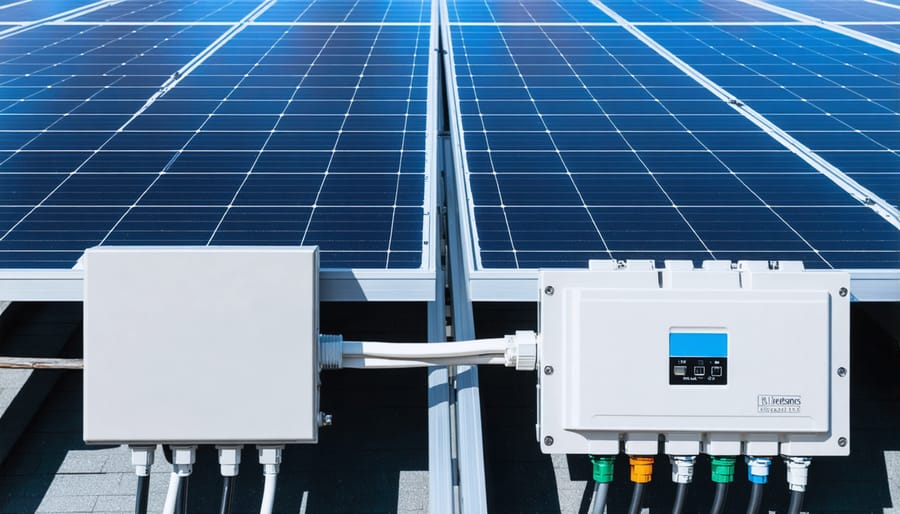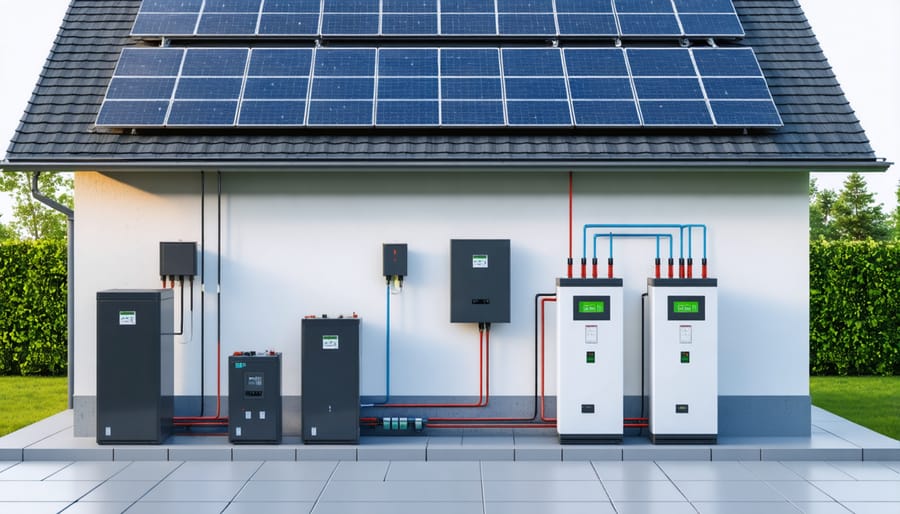Solar Panel Systems Explained: Essential Components That Power Your Home

Transform your home or business into a sustainable energy powerhouse by understanding the essential components of solar panels and their interconnected system. Modern solar installations represent a sophisticated blend of technology, combining photovoltaic modules, inverters, mounting structures, and smart monitoring solutions to harness the sun’s energy efficiently. Whether you’re planning a residential rooftop installation or a large-scale commercial project, mastering these core elements ensures optimal system performance and maximum return on investment. From the precision-engineered solar cells that capture sunlight to the advanced power management systems that integrate with the grid, each component plays a crucial role in delivering clean, renewable energy to European homes and businesses. Understanding these fundamental building blocks empowers you to make informed decisions about your solar investment while contributing to Europe’s ambitious renewable energy goals.
Solar Panels: The Power Generators

Photovoltaic Cells
Photovoltaic (PV) cells are the fundamental building blocks of solar panels, converting sunlight directly into electricity through the photovoltaic effect. These remarkable devices consist of semiconductor materials, primarily silicon, arranged in multiple layers that work together to generate electrical power.
When sunlight hits the PV cell’s surface, photons are absorbed by the semiconductor material, causing electrons to become excited and break free from their atoms. This movement of electrons creates an electric current, which is then captured and channeled through conductive materials within the cell. Modern PV cells typically achieve conversion efficiencies between 15% and 23%, with premium European manufacturers pushing these boundaries through continuous innovation.
Most residential and commercial solar panels use either monocrystalline or polycrystalline PV cells. Monocrystalline cells, crafted from single silicon crystals, offer higher efficiency and a sleeker appearance but come at a premium price. Polycrystalline cells, made from multiple silicon fragments, provide a cost-effective alternative while maintaining reliable performance.
Multiple PV cells are connected in series and parallel configurations within a solar panel to generate meaningful power output for practical applications.
Panel Frame and Glass
The frame and glass components of a solar panel play crucial roles in protecting the delicate photovoltaic cells while ensuring optimal performance and longevity. Modern solar panel frame construction typically utilizes anodized aluminum, chosen for its excellent durability, lightweight properties, and corrosion resistance in various weather conditions. This robust frame structure provides essential support while allowing for secure mounting options on different roof types.
The glass covering, typically made of tempered, low-iron glass, serves multiple protective functions while maximizing solar energy transmission. This specialized glass is engineered to withstand severe weather conditions, including hail impacts and heavy snow loads, while maintaining exceptional transparency. The anti-reflective coating applied to many modern solar panels enhances light absorption and reduces glare, improving overall system efficiency.
Together, these components create a weatherproof seal that protects the internal solar cells from moisture, dust, and other environmental factors, ensuring a typical lifespan of 25-30 years. The quality of these protective elements directly influences the panel’s performance and durability, making them essential considerations for any solar installation project.
Inverters: Converting Solar Power for Your Home
String vs. Microinverters
In the world of solar energy systems, the choice between string inverters and microinverters represents a crucial decision that significantly impacts system performance and efficiency. String inverters, traditionally the most common choice in European installations, connect multiple solar panels in a series (string) to a single central inverter. This setup offers cost-effectiveness for larger installations and simplifies maintenance with a single point of service.
Microinverters, on the other hand, operate individually on each solar panel, converting DC to AC power at the panel level. This innovative approach provides several advantages, including enhanced system reliability and improved performance in partial shading conditions. When one panel faces shade or debris, other panels in the system continue operating at maximum efficiency, unlike string inverter systems where a single underperforming panel can affect the entire string’s output.
The choice between these technologies often depends on specific installation requirements. String inverters typically suit properties with uniform roof conditions and minimal shading, offering a more budget-friendly solution for larger installations. Microinverters excel in complex installations with multiple roof orientations or partial shading issues, though they generally come with a higher initial investment.
Modern monitoring capabilities in both systems allow owners to track performance, with microinverters offering more detailed panel-level data for precise system optimization and maintenance planning.

Smart Monitoring Features
Modern solar panel systems incorporate sophisticated monitoring capabilities that revolutionise how we track and optimise energy production. Advanced inverters now come equipped with built-in monitoring features that provide real-time data on system performance, energy generation, and consumption patterns through user-friendly mobile apps or web portals.
These smart monitoring solutions enable system owners to access detailed analytics, including daily, monthly, and annual energy yields, helping them understand their energy production cycles better. The systems can detect performance issues promptly, alerting owners and maintenance teams to potential problems before they escalate into major concerns.
Many European monitoring platforms also integrate weather forecasting data, enabling users to predict their system’s output and adjust their energy consumption accordingly. This predictive capability is particularly valuable for businesses and households looking to maximise their solar investment and reduce grid dependency.
The monitoring systems can also generate comprehensive performance reports, which are especially useful for warranty claims and maintenance scheduling. Some advanced platforms even offer consumption monitoring, helping users optimise their energy usage by identifying peak consumption periods and adjusting their habits accordingly.
Mounting Systems: Securing Your Investment
The foundation of any reliable solar installation lies in its solar panel mounting systems, which play a crucial role in protecting your investment and ensuring optimal performance. These systems come in various configurations to suit different installation scenarios, from pitched roofs to flat surfaces and ground-mounted arrays.
For residential rooftop installations, rail-mounted systems are particularly popular across European markets, offering excellent stability while maintaining roof integrity. These systems typically comprise aluminum rails anchored to roof rafters through specially designed brackets and flashings that prevent water penetration. Ground-mounted options, increasingly common in rural European settings, provide maximum flexibility for optimal panel orientation and easier maintenance access.
The choice of mounting system must account for several critical factors: local wind loads, snow accumulation, and specific regional building codes. In coastal areas, corrosion-resistant materials like marine-grade aluminum or stainless steel are essential for longevity. Modern mounting solutions also incorporate integrated cable management systems and grounding features, ensuring both safety and aesthetic appeal.
Innovative ballasted systems for flat roofs have gained popularity, especially in commercial installations. These systems use weight distribution rather than roof penetration to secure panels, minimizing structural impact while maintaining stability. Some advanced mounting solutions now feature aerodynamic designs that reduce wind loads and installation time.
Professional installation of mounting systems is paramount, as proper alignment affects both energy yield and system longevity. Regular inspections ensure all components remain secure, particularly after extreme weather events, protecting your solar investment for decades to come.
Energy Storage Solutions
Battery Technologies
Modern solar installations rely heavily on efficient battery systems for storing excess energy. The two dominant technologies in today’s market are Lithium-ion and Salt-water batteries, each offering unique advantages for different applications. Lithium-ion batteries remain the most popular choice due to their high energy density, excellent home energy storage capacity, and decreasing costs. These systems typically last 10-15 years and maintain consistent performance throughout their lifespan.
Salt-water batteries have emerged as an eco-friendly alternative, using non-toxic materials and offering exceptional safety features. While they may have lower energy density, their longer lifespan of 15-20 years and minimal environmental impact make them increasingly attractive for sustainable installations.
For industrial applications, flow batteries are gaining traction, offering scalable storage solutions that can be easily expanded. These systems excel in situations requiring large-scale energy storage and can operate effectively for up to 20 years with proper maintenance.
The choice of battery technology depends on various factors, including installation size, budget, and specific energy requirements. Regular monitoring and maintenance ensure optimal performance and longevity regardless of the chosen technology.

Integration and Management
The integration of batteries with other solar system components requires careful planning and sophisticated management systems. Modern solar installations utilize smart controllers and energy management systems (EMS) to optimize the flow of power between panels, batteries, and household consumption.
These management systems continuously monitor battery charge levels, energy production, and consumption patterns to make intelligent decisions about power distribution. During peak sunlight hours, the system can simultaneously power your home and charge the batteries, while during evening hours or cloudy days, it seamlessly switches to battery power without interruption.
The integration process also includes safety features such as overcharge protection, temperature monitoring, and automatic shut-off mechanisms. Many European systems now incorporate smart monitoring capabilities, allowing owners to track system performance through mobile apps or web interfaces.
For optimal performance, the battery system must be properly sized to match both the solar array’s capacity and household energy requirements. Professional installers consider factors such as daily energy consumption, peak usage times, and seasonal variations when designing an integrated system that delivers reliable power throughout the year.
The success of a solar panel system lies in the quality and compatibility of its components, working together seamlessly to deliver reliable renewable energy. Each element, from the photovoltaic panels to the mounting systems and monitoring equipment, plays a vital role in the system’s overall performance and longevity. When investing in solar technology, it’s crucial to prioritise high-quality components that meet European standards and certifications, ensuring optimal energy production and system durability.
Proper integration of these components requires careful planning and professional expertise. A well-designed system not only maximises energy generation but also provides long-term value through reduced maintenance needs and enhanced system reliability. As solar technology continues to advance across Europe, the importance of choosing compatible, future-ready components becomes increasingly significant.
Remember that while initial costs may be higher for premium components, the long-term benefits of improved efficiency, durability, and performance make them a worthwhile investment. Working with experienced solar professionals ensures your system is properly configured, installed, and optimised for your specific energy needs, leading to decades of sustainable power generation.
Leave a Reply